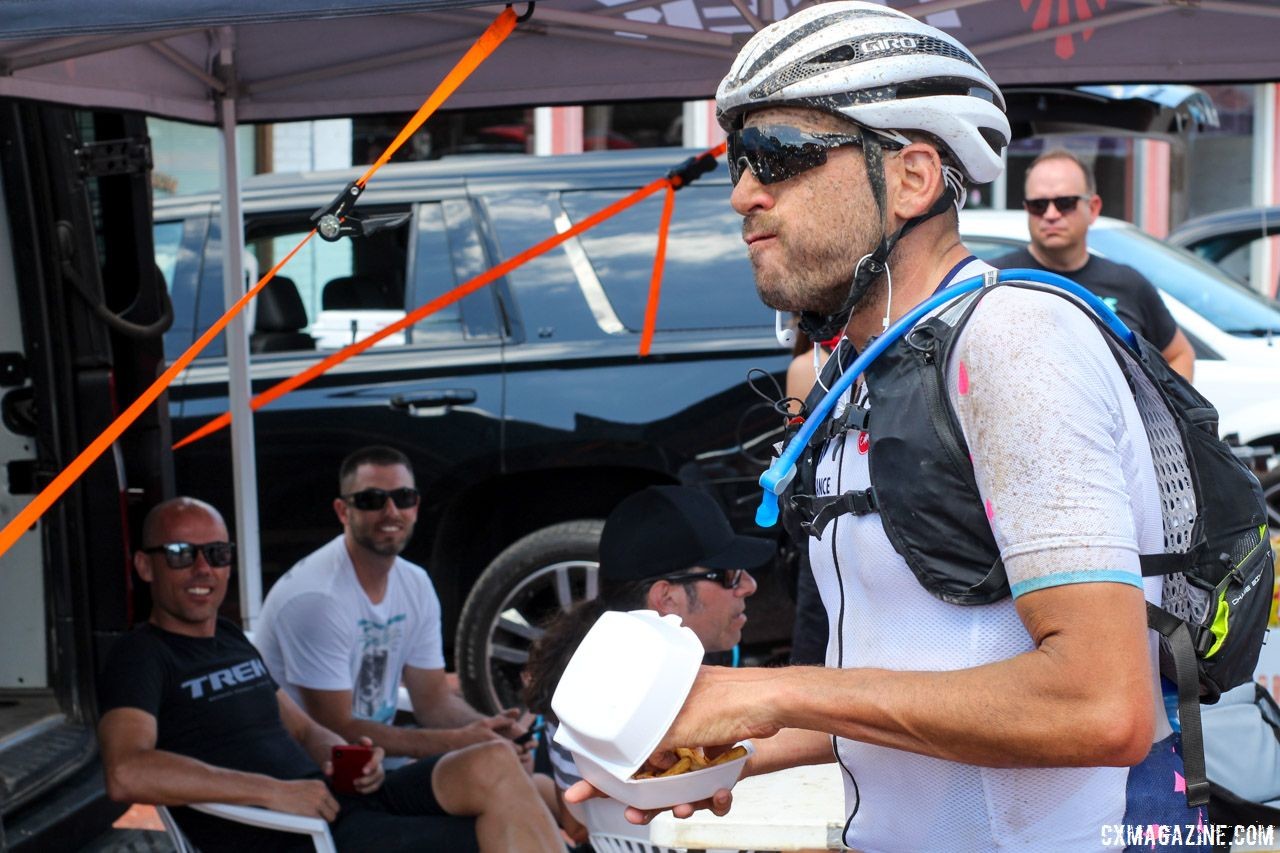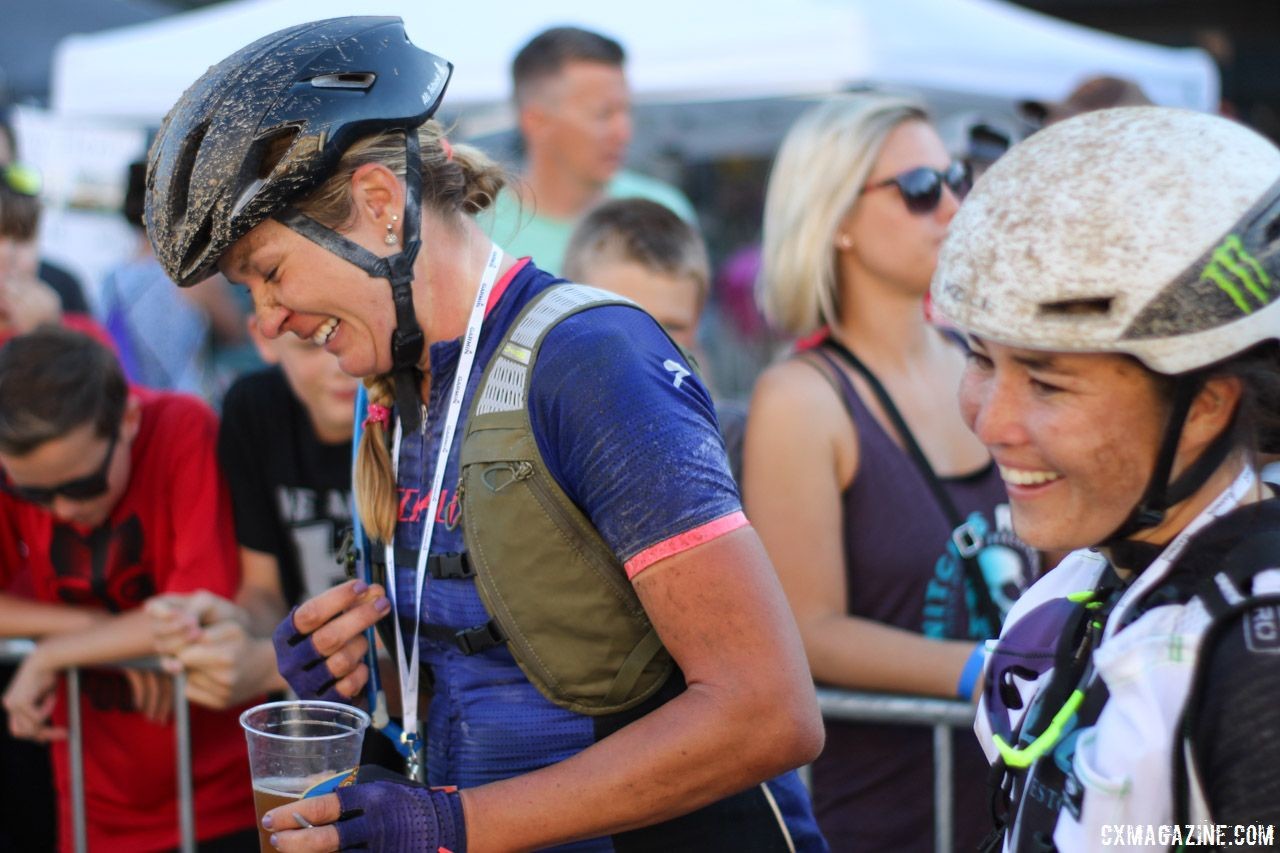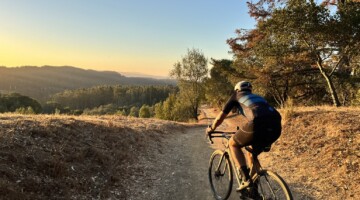Gravel racing is an eating and drinking contest. Stay fueled to stay fast, my friends. – Josh Berry
Amanda Nauman and others have long maintained that gravel racing is really an eating contest with bikes. Most of us here like bikes and eating can be pretty fun as well, so maybe that explains gravel’s popularity.
So, eat food, go fast. Simples, right?
Well, not quite that simple. A lot goes into gravel nutrition … What to eat, how often to eat, how many calories to consume. How are you going to carry your food and fluids? Are there foods that do not agree with your stomach while riding long distances?
We reassembled our group of experts from the Ask the Gravel Pros Superlatives—Kae Takeshita, Josh Berry, Corey Godfrey, Amanda Nauman and Alison Tetrick—to ask them how they stay fueled and fast during long gravel events. This time, we are going in reverse order by first name.
All five will get the chance to put their advice to the test this Saturday at the Dirty Kanza 200. For more on nutrition, see our interview with Good to Go author Christie Aschwanden.
Ask the Gravel Pros: Gravel Nutrition
Cyclocross Magazine: What do you eat during gravel races? Do you have a special go-to food?
Kae Takeshita: Tropical trail mix I buy at a local market. I remove all the nuts and give them to my husband Dan and keep the dried fruits to eat on the bike. This way I get assortment and he gets nuts to snack on, a win-win situation. I do carry some gels, energy bars and energy chews, too; it’s a pocketful! I don’t have one specific go-to food but bring a variety.
Josh Berry: Whatever I can get my hands on. Ted King gave me plenty of UnTapped Maple gels at the Dirty Kanza last year; so yummy plus they saved me. Pancetta gruyere rice cakes are my favorite thing to make for a bougie snack I am always stoked to open. I am a fan of jalapeño chips and Heath bars at gas stations paired with the drink that got me through my ski tuning days, Starbucks double shots.
Bananas are my go-to. They are the perfect food and they are naturally packaged. You cannot go wrong. Just make sure you open them like a primate, your future or current lover will appreciate it each time.
Corey Godfrey: My dietary choices are all over the place. Nuts, trail mix, fruit snacks, soft energy bars and sometimes the occasional garbage—donuts, pizza and candy. I eat whatever sounds good at the moment but try to avoid really heavy foods such as fried or greasy foods. My main focus is on keeping calories onboard consistently throughout the event without any huge influxes.
Amanda Nauman: Whatever I’ve been training with around that time. I say that because there’s been nothing consistent about my nutrition plans during the past five years. Food choices evolve, but I always suggest people go with what they’ve been training with and nothing new on event day. For example, don’t plan to eat 10 gels in the first 5 hours unless you’ve actually tried that on a training ride and know your gut can handle it.
Use long training weekends and practice events to try different nutrition strategies. My go-to lately has been gummy worms. Stick to low-fiber choices for easy digestion and plan for salt cravings at the tail end of the long events.
Alison Tetrick: My nutrition depends on the duration of the event. When the intensity is harder and more “race like” at the beginning, I tend to fuel like I would in a road race. I stick to simple carbohydrates such as GU Energy gels and GU Energy chomps.
As the race distance increases and you get beyond that 5-6 hour mark, I start adding in more whole foods and listen to what my body needs. I have been known to crave everything from potato chips to frosted circus animal cookies to donut holes to beef jerky.
I think the trick is to eat early and often. Sometimes during the beginning of the event you may not be thirsty or hungry yet, but you can really put yourself into a deficit if you don’t take care of yourself from hour one.
Cyclocross Magazine: How often do you eat? Calorie goal per hour?
Kae Takeshita: Whenever the ground is smooth(er) and steady(ier) and there is no worry that I’d lose the food I am holding.
Josh Berry: Training I eat every hour. Racing every 30 minutes. I am a big boy so 300 calories is my goal.
Corey Godfrey: I try to eat at least once an hour with a goal of getting 300 to 400 calories in per hour. Getting calories in early and often is vital to fending off stomach issues later in the day. Waiting too long to eat and then stuffing oneself at a checkpoint often leads to overeating with subsequent stomach issues and heavy legs.
Amanda Nauman: I aim for 200-250 calories per hour depending on the event and the effort.
Alison Tetrick: I aim to consume about 250 calories per hour and at least 1 bottle per hour. I think it is easy to put calories in your bottle and then you consume one other item per hour. Such as one GU Stroopwafel and one bottle of electrolytes.
Cyclocross Magazine: What else have you tried that didn’t work? Why?
Kae Takeshita: Nutrition on the bike is a constant trial and error process. I know what works and stick to it, and I definitely know what doesn’t work for me. For instance, anything with sorbitol does not agree with me. I do try new products but read the ingredients carefully.
Josh Berry: Not eating is a good way to be slow. I have always struggled with my weight, and it’s a real battle for many people to find what works for them. Sure I have been skinny but man, did I have no power. I have found if I really crush the food in hard training, I feel better all the time and lose more weight as I am boosting my metabolism.
In typical training days, I stick to eating something every hour, making sure it is something I enjoy that is not a fat. Healthy fat after the ride is awesome, I live on that. Cultured salted butter, avocados, coconut oil and nut butter are all strong figures in the calories I no longer count.
Corey Godfrey: Dense dry energy bars and straight liquid calories have never agreed with my stomach. I really enjoy food, so depriving myself of the food I enjoy only makes the event more difficult.
Amanda Nauman: Those anti-cramping hotshots do not work for me. I fought nausea at the Belgian Waffle Ride a couple years ago from the spicy flavor in those. I don’t think spicy is good for my gut at any sort of intensity.
Also loading calories at checkpoints does not work; that’s a mistake I made once and will never make again. Keeping the flow of calories consistent is better than trying to digest a whole sandwich or entire pizza at a checkpoint.
Alison Tetrick: One time I had a smoked salmon omelet before a criterium. I don’t recommend that. My theory is that anything you put in your body you should be happy with the taste if you need to regurgitate it! Apple fritters are fantastic for that. I recommend donuts.
Cyclocross Magazine: Do you have a post-race food “reward?”
Kae Takeshita: During the week I stick to a specific diet, so I look forward to the finish of the event as an opportunity to go shopping and splurge on some dessert.
Josh Berry: A tall boy Michelada Picante and a smoke or two as I drive away in my Camaro.
Corey Godfrey: I’m a big fan of chocolate milk and a couple of bananas. Post-race food should be nutrient dense. Getting plenty of fluids and some calories within 30 minutes of finishing is my number 1 priority. The recovery goes a lot easier if you eat well after crossing the finish line. That’s the best time to replace the depleted glycogen stores.
Amanda Nauman: Nothing specific, just whatever I’m craving. I’d say it’s normally something salty, not sweet. After a Muscle Monster there’s definitely alcohol involved in some form or another.
Alison Tetrick: Bourbon? Pizza? Burgers? Margaritas? Nachos? Do I really need to make a list? Anything and everything. Every day is meant to be celebrated. Life and living is a reward in itself, not just completing a gravel event.

Sometimes frites are what you need to finish a gravel event. 2018 Dirty Kanza 200. © Z. Schuster / Cyclocross Magazine
Cyclocross Magazine: What hydration gear do you use during a 100-mile race? 200-miler like the Dirty Kanza 200?
Kae Takeshita: I usually just use bottles, but depending on the temperature, availability of water and span of checkpoints, I opt for a hydration backpack as well. When I have multiple bottles I can use different flavor in each bottle, making my taste buds a little happier rather than having the same flavor all day long.
Josh Berry: I mix maple syrup, lemon and sea salt in bottles. If I have to grab something packaged, I go for UnTapped then Skratch. I always have a bottle of just water in case my body is not liking the sugars I am in taking.
DK200 with rest stops? I am sticking to half bottles of water and half bottles mix. I will have some single serving UnTapped without caffeine and a hyper hydration by Osmo Nutrition or Skratch.
Corey Godfrey: I try to use bottles for all the gravel events as I don’t enjoy having extra weight on my back. I have some liter bottles that I currently use. For extremely hot and humid events with distances greater than 75 miles between water stops, I’ll use a hydration pack.
Calculating consumption based on the ambient conditions dictates the decision. Last year at DKXL I chose to use a hydration pack in order to ensure I had enough fluids. I’m really glad I did.
Amanda Nauman: Big bottles that are 26 ounces and Orange Mud packs, either the 1L Gear Vest or 2L Endurance Pack.
Alison Tetrick: During the longer events it is helpful to wear a hydration pack, such as the Camelbak Chase vest, which carries an additional 1.5 liters of fluid to ensure you are hydrated. With each aid station at the DK200, I pick up a fully filled Camelbak Chase vest and 2 new bottles for the next leg of the journey.
Cyclocross Magazine: Do you drink just water or a sports drink?
Kae Takeshita: I don’t have just one particular one I use. There are so many nutrition products out there and I like trying new products and flavors. I do not stick with one flavor. After many many uses of the same product with the same flavor, there will be one day it starts to taste awful. It may happen during a long race, so each bottle has a different taste.
There are often single serving packets available, and whenever I get a chance, I give a new one a shot. I’ve tried many of the major ones that you see in the bike shops. It’s good to know what I like but also important to know what I do not like.
Josh Berry: A mix. I prefer to rely on whole foods and natural sugars. You will see me with a Coke and whatever mix the race is giving out as in these long events you have to take what you can get.
Corey Godfrey: The hydration strategy depends on the ambient conditions. If it’s early in the season and cooler, I’ll go with straight water and supplement with a sports drink at stops. In hotter, humid conditions, I’ll go with a drink mix that has electrolytes and some calories throughout the entire event. Less sweet the better.
Amanda Nauman: Drink mix and electrolyte tabs in bottles or bladders. For the longer events I’ll use my Orange Mud packs, which have been a lifesaver for long durations. I go against the grain of traditional practice by putting drink mix in the Orange Mud bladders so I can guarantee easy calories into my system. I’ve discovered it’s hard for me to eat at the beginning of hectic gravel events because of the bike handling, so easy access to calories in the bladder has been crucial for me because I don’t have to take my hands off the bars and dig for food in pockets.
Alison Tetrick: I stick to GU Energy Roctane electrolytes in my bottles. Like I said previously, I try to ensure I consume 1 bottle per hour.

Alison Tetrick can always be seen with her hydration pack … and maybe a post-race beer. 2018 Women’s Dirty Kanza 200. © Z. Schuster / Cyclocross Magazine
Cyclocross Magazine: Any stories of bonking during a gravel race?
Kae Takeshita: Not necessarily on a gravel ride but there were times that my energy level was low due to lack of calorie consumption. I get sleepy on the bike, and it’s not really a good thing. My brain needs some sugar! When it’s cold you need to consume more calories.
Josh Berry: I cracked on my last ride. I have been doing XC mountain bike racing, and I am burning way more sugar than I am used to as a fat-burning stage racer. I missed the 1-hour window as I was having so much fun ripping some singletrack on my Giant Revolt. At the climb out I was dead, but thanks to some extra fuel as soon as I smashed some Honey Stinger Chews, I was able to be back on top of power and glide home.
Gravel racing is an eating and drinking contest. Stay fueled to stay fast, my friends.
Corey Godfrey: Oh yeah! I’ve had some really dark moments before where I questioned every decision I’ve ever made in my life after having a full-fledged bonk hit me square in the teeth. I’ve hit the wall so hard I didn’t feel human anymore. Primal instincts kicked in and all rational thought processes were put on pause. All I could think about was food. Usually something very sweet and easy to consume. Chocolate or Twinkies have been the go-to for bonk fixation in the past.
Waiting too long to eat and underestimating my caloric needs have led to bonks. Sometimes I just run out of food because I was on the course for longer than expected due to a mechanical or less than favorable roads conditions. Carrying some extra food is worth the weight to fend off a bonk.
Other times, I’ve bonked because I’ve ridden on the rivet for too long and refused to sit up and eat. I didn’t want to lose a wheel or get dropped from a group. Well, bonking will lead to both and much worse. Lessons learned and often forgotten when in the heat of the moment.
Amanda Nauman: Not that I can remember. If you ask any of my friends they’ll tell you I’m really good at eating and drinking on rides. I always have a back-up stash of calories just in case something goes wrong and I’m out for longer than I initially planned. I’ve probably been dehydrated more often than I’ve been behind on calories. Always be eating!
Alison Tetrick: No! Never. Ha. The thing I love most about these endurance gravel races is that I have pushed my body beyond limits I did not even know were possible.
The first time I showed up to DK200, I had never ridden over 125 miles. I didn’t know how my body would handle it, and it brought all the sides of crazy out. I mean, I saw storm troopers out there!
I think I was fueled for the adventure, but perhaps we often ignore the emotional and mental energy that is required to keep pushing forward. Your body performs the best if you take care of all sides of it, and that can come from your training and your fueling preparation but also your visualization and positive self-talk.
We’ve got this! Wait, who is we? Last I checked it was just me and my bicycle all alone. Well, at least someone is listening to my crazy.



























